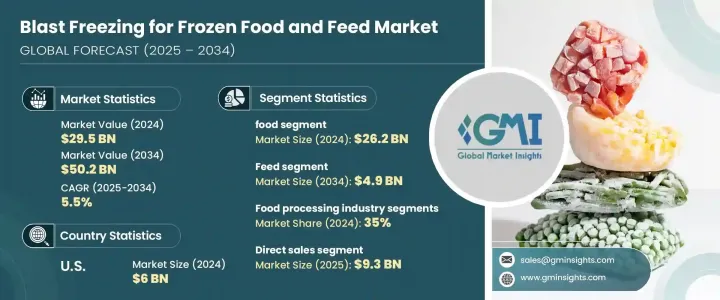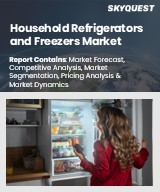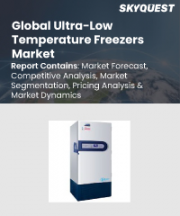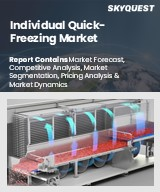
|
시장보고서
상품코드
1750454
세계의 냉동 식품 및 사료용 급속 동결 시장 : 기회, 성장 촉진요인, 산업 동향 분석 및 예측(2025-2034년)Blast Freezing for Frozen Food and Feed Market Opportunity, Growth Drivers, Industry Trend Analysis, and Forecast 2025 - 2034 |
||||||
세계의 냉동식품 및 사료용 급속 동결 시장은 2024년에는 295억 달러로 평가되었고 고품질의 냉동식품, 편리한 조리된 식품, 엄격한 식품안전규제에 대한 수요의 급증으로 2034년에는 502억 달러에 달할 것으로 추정되며, CAGR 5.5%로 성장할 전망입니다.
금속 동결은 다양한 식품의 식감, 풍미, 영양가를 유지하고 보존 기간을 연장하는데 있어서 매우 중요합니다.이 방법은 식품 가공, 해산물, 육류, 베이커리 등의 산업에서 일반적으로 사용되고 있어, 금속 동결에 의해 제품을 최적인 상태로 보존할 수 있습니다.

급속 동결 기술은 제품이 최상의 신선도를 유지하도록 보존함으로써 식품 폐기물을 줄이는 데 기여합니다. 이는 유통기한을 연장하고 부패를 최소화하기 때문입니다. 이는 제조업체, 소매업체, 소비자가 모두 중요하게 여기는 재고 관리와 폐기물 감소를 위해 식품 산업에서 특히 중요합니다. 식품 공급망 내에서 지속 가능성과 효율성에 대한 관심이 높아짐에 따라, 품질 관리 및 폐기물 감소를 위한 필수 도구로 금속 동결이 채택되고 있습니다. 또한, 특히 개발도상국에서 냉동 제품에 대한 수요가 계속 증가함에 따라, 에너지 소비를 줄이면서 제품의 무결성을 유지하는 첨단 냉동 기술의 필요성이 점점 더 중요해지고 있습니다.
| 시장 범위 | |
|---|---|
| 시작 연도 | 2024년 |
| 예측 연도 | 2025-2034년 |
| 시작 금액 | 295억 달러 |
| 예측 금액 | 502억 달러 |
| CAGR | 5.5% |
인간 소비 분야는 2025년에 217억 달러에 이르렀으며, 2034년까지 연평균 성장률(CAGR)은 5.8%로 성장할 전망입니다. 이 부문은 품질과 안전성을 유지하기 위해 급속 동결 기술을 의존하는 다양한 제품을 포함합니다. 육류, 수산물, 채소, 즉석 식품, 제과 제품 등은 급속 동결 기술의 혜택을 가장 많이 받는 식품입니다. 이 과정은 동결 과정에서 텍스처, 맛, 영양 가치를 유지함으로써 엄격한 식품 안전 기준을 준수하며 전 세계 식품 유통에 필수적입니다. 도시화 및 편리한 즉석 식품 수요가 계속 증가함에 따라 급속 동결 기술은 동결 식품의 품질과 안전성을 유지하는 데 더욱 중요한 역할을 하게 될 것입니다.
시장은 제품 유형별로 식품과 사료로 구분되며, 식품이 지배적인 부문으로, 2024년 시장 규모는 262억 달러입니다. 식품 부문은 육류, 수산물, 유제품, 과일, 채소, 제과 제품 등 급속 동결이 필요한 다양한 제품을 포함합니다. 도시화와 함께 온라인 식료품점 및 소매업의 발전도 이 시장의 성장을 촉진하는 요인이 되었습니다. 또한, 편의 식품 및 유통 기한이 긴 제품에 대한 수요가 증가하면서 금속 동결 솔루션에 대한 수요도 계속 증가하고 있습니다. 시장의 상당 부분을 차지하는 식품 가공 산업은 품질 보증을 위해 원료 및 완제품을 보존하기 위해 금속 동결을 사용합니다.
미국의 냉동 식품 및 사료용 금속 동결 시장은 고급 냉동 방법의 소비 및 채택에 힘입어 2024년에 60억 달러의 매출을 올렸습니다. IoT 지원 금속 동결고와 같은 혁신을 통해 제품 품질을 유지하면서 운영 효율성을 개선하고 에너지 소비를 20%까지 줄일 수 있게 되었습니다. 또한, 소비자와 기업 모두 환경에 대한 책임을 더욱 중요하게 생각함에 따라 이산화탄소 및 암모니아와 같은 보다 지속 가능한 냉매로 전환하는 추세가 확산되고 있습니다.
냉동 식품 및 사료용 급속 동결시장의 주요 기업으로는 McCain Foods, General Mills, Charoen Pokphand Foods, Archer Daniels Midland(ADM), Conagra Brands 등이 있습니다. 이들 기업은 에너지 효율적이고 자동화된 동결 솔루션 개발, 제품 포트폴리오 확장, 지속 가능성 강조 등을 통해 시장 지위를 강화하기 위한 전략을 추진하고 있습니다. 혁신적인 기술 도입과 운영 효율성 개선을 통해 이들은 고품질 동결 식품에 대한 증가하는 수요를 충족시키며 경쟁 우위를 유지하는 것을 목표로 하고 있습니다.
목차
제1장 조사 방법과 범위
제2장 주요 요약
제3장 업계 인사이트
- 생태계 분석
- 밸류체인에 영향을 주는 요인
- 이익률 분석
- 혁신
- 장래의 전망
- 제조업자
- 리셀러
- 트럼프 정권에 의한 관세에 대한 영향
- 무역에 미치는 영향
- 무역량의 혼란
- 보복 조치
- 업계에 미치는 영향
- 공급측의 영향(원재료)
- 주요 원재료의 가격 변동
- 공급망 재구성
- 생산 비용에 미치는 영향
- 수요측의 영향(판매가격)
- 최종 시장에의 가격 전달
- 시장 점유율 동향
- 소비자의 반응 패턴
- 공급측의 영향(원재료)
- 영향을 받는 주요 기업
- 전략적인 업계 대응
- 공급망 재구성
- 가격 설정 및 제품 전략
- 정책관여
- 전망과 향후 검토 사항
- 무역에 미치는 영향
- 무역 통계(HS코드)
- 주요 수출국(2021-2024년)
- 주요 수입국(2021-2024년)
참고 : 위의 무역 통계는 주요 국가에만 제공됩니다.
- 공급자의 상황
- 주요 뉴스와 대처
- 영향요인
- 성장 촉진요인
- 수산물 및 육류 가공 분야에서 빠르고 효율적인 동결 방법에 대한 수요 증가
- 냉동 식품 및 사료 시스템에서 극저온 동결 및 공기 분사 동결에 비해 비용 효율성과 확장성
- 더 긴 유통 기한과 제품 품질 유지가 필요한 수출 시장 확대
- 업계의 잠재적 위험 및 과제
- 제품의 맛과 품질에 영향을 미치는 염분 흡수 위험
- 급속 폐기 및 수질 오염에 대한 환경적 우려
- 위생 기준 및 식품 안전 준수 관련 규제 압력
- 성장 촉진요인
- 성장 가능성 분석
- Porter's Five Forces 분석
- PESTEL 분석
- 공급망과 밸류체인 분석
- 급속 동결 제품의 공급망 개요
- 원재료 조달 및 구매
- 급속 동결 제품의 생산 및 가공
- 냉동 보관 및 창고 관리
- 유통과 물류
- 소매 및 최종 소비자 배송
- 밸류체인 최적화 전략
- 공급망 과제 및 해결 방안
- 공급 체인의 기술 통합
- 공급망 내 지속 가능성 대처
- 규제 환경 및 준수
- 급속 동결 제품에 대한 세계의 규제 프레임워크
- 식품 안전 기준과 규제
- 금속 동결 식품에 관한 FDA 규제(미국)
- 금속 동결 식품에 관한 EFSA 규제(유럽 연합)
- 금속 동결 식품에 관한 FSSAI 규제(인도)
- 기타 지역규제
- 동물사료에 관한 규제와 기준
- 동물사료에 관한 FDA 규제(미국)
- 동물사료에 관한 EU 규제
- 기타 지역의 사료 규제
- 금속 동결 제품의 표시 및 포장 규제
- 콜드 체인 준수 요건
- 품질 보증 및 인증 기준
- 업계에 영향을 주는 환경규제
- 규제 동향과 향후 전망
- 시장 참여자를 위한 규정 준수 전략
- 소비자 행동과 시장 동향
- 금속 동결 식품에 대한 소비자의 선호도
- 급속 동결 제품의 품질 인식
- 품질의 기대와 만족도
- 가격 감도 분석
- 건강과 영양에 대한 의식의 영향
- 편리성 요인의 영향
- 지속가능성에 대한 우려와 환경친화적인 포장
- 디지털의 영향과 온라인 구매 행동
- 소비자 기반의 인구 통계 분석
- 새로운 소비자 동향
- 비용 분석과 경제적 영향
- 금속 동결 식품의 가격 분석
- 금속 동결 사료 제품의 가격 분석
- 비용 구조 분석
- 밸류체인 전체의 마진 분석
- 기존 냉동 제품과의 가격 비교
- 식품 보존 및 폐기물 감축에 대한 경제적 영향
- 식품 안전성에 대한 경제적 기여
- 비용 최적화 전략
- 재무 모델링과 예측
- 제품의 혁신과 미래의 전망
- 금속 동결 식품의 새로운 제품 혁신
- 클린 라벨 금속 동결 제품
- 유기농 및 내츄럴 금속 동결 제품
- 기능성 강화 냉동 식품
- 식물 유래의 금속 동결 대체품
- 금속 동결 사료의 새로운 제품 혁신
- 영양 강화 사료 제품
- 특수 사료 배합
- 지속 가능한 사료 솔루션
- 금속 동결 제품의 포장 혁신
- 새로운 보존 기술
- 향후 제품 개발 로드맵
- 소비자 주도의 혁신의 동향
- 연구개발의 중점분야
- 금속 동결 식품의 새로운 제품 혁신
- 투자분석과 기회
- 금속 동결 식품에 대한 투자 동향
- 금속 동결 사료 제품에 대한 투자 동향
- 벤처캐피탈 및 프라이빗 주식활동
- 합병과 인수의 상황
- 스타트업 생태계 및 혁신 허브
- 고성장 투자 부문
- 지역 투자 핫스팟
- 위험 평가 및 완화 전략
- ROI 분석 및 회수 기간
- 투자 사례
- 미래 투자 전망
- 지속가능성과 환경에 미치는 영향
- 금속 동결 제품의 환경 풋 프린트
- 생산과 저장에 있어서의 에너지 효율
- 지속 가능한 원재료 조달
- 폐기물 감축 및 관리
- 수자원 보전 전략
- 이산화탄소 배출량 감소 접근법
- 순환형 경제의 실천
- 지속가능성 인증 및 기준
- 지속 가능한 관행에 대한 소비자의 인식
- 미래의 지속가능성 로드맵
- 주요 이해관계자를 위한 전략 분석
- 최고 경영진 위한 전략적 통찰
- 시장 진입과 확대 전략
- 경쟁상의 포지셔닝에 관한 추천 사항
- 투자 우선순위화 프레임워크
- 위험 관리 접근
- 제품 관리팀을 위한 전략적 인사이트
- 제품 개발 로드맵
- 혁신 파이프라인 관리
- 제품 수명주기 최적화
- 가격 설정 및 포지셔닝 전략
- 기술팀을 위한 전략적 인사이트
- 기술 도입 프레임워크
- 디지털 변혁 로드맵
- 첨단 기술의 통합
- 연구개발 중점분야
- 마케팅팀을 위한 전략적 인사이트
- 시장 세분화 및 타겟팅
- 브랜드 포지셔닝 전략
- 커뮤니케이션과 메시징의 프레임워크
- 채널 전략 최적화
- 영업팀을 위한 전략적 인사이트
- 고객 획득 전략
- 계정 관리의 접근
- 가치 제안의 개발
- 판매 프로세스 최적화
- 최고 경영진 위한 전략적 통찰
- 위험 평가 및 경감 전략
- 금속 동결 제품 시장위험분석
- 제품의 품질과 안전성의 위험
- 규제 위험 평가
- 공급망의 취약성
- 경쟁 위험 분석
- 재무위험평가
- 환경과 지속가능성의 위험
- 지정학적 위험 평가
- 종합적인 위험 경감 프레임워크
- 위기관리계획
- 장래 시장 전망과 시나리오 계획
- 금속 동결 제품의 단기 시장 예측(1-2년)
- 중기 시장 예측(3-5년)
- 장기 시장 예측(5-10년)
- 신흥 시장의 기회
- 잠재적인 시장 혼란 요인
- 제품 진화 시나리오
- 규제의 진화 시나리오
- 소비자 행동의 진화 시나리오
- 경쟁 구도의 진화
- 미래 대비를 위한 전략적 제안
제4장 경쟁 구도
- 소개
- 기업의 시장 점유율 분석
- 경쟁 포지셔닝 매트릭스
- 전략적 전망 매트릭스
제5장 시장 추계 및 예측 : 제품 유형별(2024-2034년)
- 주요 동향
- 음식
- 육류 및 가금류
- 붉은 육류
- 가금류
- 가공육 제품
- 해산물
- 물고기
- 갑각류
- 연체동물
- 과일 및 채소
- 베리류와 과일
- 잎 야채
- 뿌리채소
- 혼합 야채
- 베이커리 제품
- 빵과 롤
- 과자 및 디저트
- 피자 도우
- 유제품
- 아이스크림과 냉동 디저트
- 치즈 제품
- 기타 유제품
- 조리된 식품과 인스턴트 식품
- 완전 식사
- 전채 요리 및 간식
- 민족 요리와 특산품
- 육류 및 가금류
5.2.7 기타
- 허브와 향신료
- 소스와 조미료
- 먹이
- 가축 사료
- 소 사료
- 가금류 사료
- 돼지 사료
- 수산 사료
- 생선 사료
- 갑각류 사료
- 반려동물 사료
- 개 사료
- 고양이 사료
- 기타 반려동물 사료
- 특수 동물사료
- 동물원의 동물 사료
- 실험 동물 사료
- 가축 사료
제6장 시장 추계 및 예측 : 최종 용도별(2024-2034년)
- 주요 동향
- 식품가공업계
- 외식산업
- 소매점 및 슈퍼마켓
- 동물사료 제조업체
- 제약업계
- 기타
제7장 시장 추계 및 예측 : 유통 채널별(2024-2034년)
- 주요 동향
- 직접 판매
- 판매자 및 도매업체
- 소매점
- 온라인 소매
- 기타
제8장 시장 추계 및 예측 : 용도별(2021-2034년)
- 주요 동향
- 인간 소비
- 동물 소비
- 산업 용도
제9장 시장 추계 및 예측 : 지역별(2024-2034년)
- 주요 동향
- 북미
- 미국
- 캐나다
- 유럽
- 독일
- 영국
- 프랑스
- 스페인
- 이탈리아
- 러시아
- 아시아태평양
- 중국
- 인도
- 일본
- 호주
- 한국
- 라틴아메리카
- 브라질
- 멕시코
- 아르헨티나
- 중동 및 아프리카
- 사우디아라비아
- 남아프리카
- 아랍에미리트(UAE)
제10장 기업 프로파일
- Archer Daniels Midland (ADM)
- Charoen Pokphand Foods
- Conagra Brands
- General Mills
- McCain Foods
- Nestle S.A.
- Nomad Foods
- Tyson Foods
- Unilever
- Machine manufacturer
- Lineage Logistics
- Americold
- United States Cold Storage
- InterChange Cold Storage
The Global Blast Freezing for Frozen Food and Feed Market was valued at USD 29.5 billion in 2024 and is estimated to grow at a CAGR of 5.5% to reach USD 50.2 billion by 2034, driven by the surge in demand for high-quality frozen food, convenient ready-to-eat meals, and strict food safety regulations. Blast freezing is crucial in maintaining the texture, flavor, and nutritional value of a wide range of food products while extending their shelf life. This method is commonly used in industries like food processing, seafood, meat, and bakery, where rapid freezing ensures products are preserved in optimal conditions.

Blast freezing technology helps in reducing food waste by preserving products at their peak freshness, which extends shelf life and minimizes spoilage. This is particularly vital in the food industry, where managing inventory and reducing waste are key concerns for manufacturers, retailers, and consumers alike. The growing focus on sustainability and efficiency within food supply chains is driving the adoption of blast freezing as an essential tool for quality control and waste reduction. Additionally, as the demand for frozen products continues to rise, particularly in developing markets, the need for advanced freezing techniques that maintain the integrity of the product while reducing energy consumption is becoming increasingly critical.
| Market Scope | |
|---|---|
| Start Year | 2024 |
| Forecast Year | 2025-2034 |
| Start Value | $29.5 Billion |
| Forecast Value | $50.2 Billion |
| CAGR | 5.5% |
The human consumption segment is set to reach USD 21.7 billion in 2025, growing at a 5.8% CAGR through 2034 encompassing a wide range of products that rely on blast freezing to preserve their quality and safety. Meats, seafood, vegetables, ready meals, and bakery products are among the most common foods that benefit from blast freezing technology. By ensuring the preservation of texture, flavor, and nutritional value during freezing, this process is vital for the global distribution of food while adhering to stringent food safety standards. As urbanization and the demand for convenient, ready-to-eat meals continue to rise, the role of blast freezing in maintaining the quality and safety of frozen foods becomes even more critical.
The market is segmented by product type into food and feed, with food being the dominant segment, valued at USD 26.2 billion in 2024. The food segment includes a broad range of products such as meat, seafood, dairy, fruits, vegetables, and bakery goods, which require blast freezing for preservation. Urbanization, alongside the rise of online grocery stores and retail development, has also played a role in boosting this market. Additionally, the increasing need for convenience foods and products with longer shelf lives continues to drive the demand for rapid freezing solutions. The food processing industry, which holds a significant portion of the market, uses blast freezing to preserve raw materials and finished products for quality assurance.
United States Blast Freezing for Frozen Food and Feed Market generated USD 6 billion in 2024, driven by the consumption and the adoption of advanced freezing methods. Innovations such as IoT-enabled blast freezers have improved operational efficiency and reduced energy consumption by 20%, all while maintaining product quality. Additionally, the shift to more sustainable refrigerants, like carbon dioxide and ammonia, is gaining traction as consumers and businesses alike place more emphasis on environmental responsibility.
Key players in the Blast Freezing for Frozen Food and Feed Market include McCain Foods, General Mills, Charoen Pokphand Foods, Archer Daniels Midland (ADM), and Conagra Brands. These companies are leveraging strategies such as the development of energy-efficient and automated freezing solutions, expanding their product portfolios, and focusing on sustainability to enhance their market positions. By introducing innovative technologies and improving operational efficiencies, they aim to meet the increasing demand for high-quality, frozen food products while maintaining competitive advantages.
Table of Contents
Chapter 1 Methodology and Scope
- 1.1 Market scope and definition
- 1.2 Base estimates and calculations
- 1.3 Forecast calculation
- 1.4 Data sources
- 1.4.1 Primary
- 1.4.2 Secondary
- 1.4.2.1 Paid sources
- 1.4.2.2 Public sources
- 1.5 Primary research and validation
- 1.5.1 Primary sources
- 1.5.2 Data mining sources
Chapter 2 Executive Summary
- 2.1 Industry synopsis, 2021 - 2034
Chapter 3 Industry Insights
- 3.1 Industry ecosystem analysis
- 3.1.1 Factor affecting the value chain
- 3.1.2 Profit margin analysis
- 3.1.3 Disruptions
- 3.1.4 Future outlook
- 3.1.5 Manufacturers
- 3.1.6 Distributors
- 3.2 Trump administration tariffs
- 3.2.1 Impact on trade
- 3.2.1.1 Trade volume disruptions
- 3.2.1.2 Retaliatory measures
- 3.2.2 Impact on the industry
- 3.2.2.1 Supply-side impact (raw materials)
- 3.2.2.1.1 Price volatility in key materials
- 3.2.2.1.2 Supply chain restructuring
- 3.2.2.1.3 Production cost implications
- 3.2.2.2 Demand-side impact (selling price)
- 3.2.2.2.1 Price transmission to end markets
- 3.2.2.2.2 Market share dynamics
- 3.2.2.2.3 Consumer response patterns
- 3.2.2.1 Supply-side impact (raw materials)
- 3.2.3 Key companies impacted
- 3.2.4 Strategic industry responses
- 3.2.4.1 Supply chain reconfiguration
- 3.2.4.2 Pricing and product strategies
- 3.2.4.3 Policy engagement
- 3.2.5 Outlook and future considerations
- 3.2.1 Impact on trade
- 3.3 Trade statistics (HS Code)
- 3.3.1 Major exporting countries, 2021 - 2024 (Kilo Tons)
- 3.3.2 Major importing countries, 2021 - 2024 (Kilo Tons)
Note: the above trade statistics will be provided for key countries only
- 3.4 Supplier landscape
- 3.5 Key news and initiatives
- 3.6 Impact forces
- 3.6.1 Growth drivers
- 3.6.1.1 Rising demand for fast and efficient freezing methods in seafood and meat processing.
- 3.6.1.2 Cost-effectiveness and scalability compared to cryogenic and air-blast freezing for frozen food and feed systems.
- 3.6.1.3 Growing export markets requiring longer shelf life and maintained product quality.
- 3.6.2 Industry pitfalls and challenges
- 3.6.2.1 Risk of salt absorption affecting product taste and quality.
- 3.6.2.2 Environmental concerns over blast disposal and water contamination.
- 3.6.2.3 Regulatory pressures around hygiene standards and food safety compliance.
- 3.6.1 Growth drivers
- 3.7 Growth potential analysis
- 3.8 Porter's analysis
- 3.9 PESTEL analysis
- 3.10 Supply chain and value chain analysis
- 3.10.1 Supply chain overview for blast frozen products
- 3.10.2 Raw material sourcing and procurement
- 3.10.3 Production and processing of blast frozen products
- 3.10.4 Cold storage and warehousing
- 3.10.5 Distribution and logistics
- 3.10.6 Retail and end-user delivery
- 3.10.7 Value chain optimization strategies
- 3.10.8 Supply chain challenges and solutions
- 3.10.9 Technology integration in supply chain
- 3.10.10 Sustainability initiatives in the supply chain
- 3.11 Regulatory landscape and compliance
- 3.11.1 Global regulatory framework for blast frozen products
- 3.11.2 Food safety standards and regulations
- 3.11.2.1 FDA regulations for blast frozen foods (United States)
- 3.11.2.2 EFSA regulations for blast frozen foods (European Union)
- 3.11.2.3 FSSAI regulations for blast frozen foods (India)
- 3.11.2.4 Other regional regulations
- 3.11.3 Animal feed regulations and standards
- 3.11.3.1 FDA regulations for animal feed (United States)
- 3.11.3.2 EU regulations for animal feed
- 3.11.3.3 Other regional feed regulations
- 3.11.4 Labeling and packaging regulations for blast frozen products
- 3.11.5 Cold chain compliance requirements
- 3.11.6 Quality assurance and certification standards
- 3.11.7 Environmental regulations impacting the industry
- 3.11.8 Regulatory trends and future outlook
- 3.11.9 Compliance strategies for market participants
- 3.12 Consumer behavior and market trends
- 3.12.1 Consumer preferences for blast frozen food products
- 3.12.2 Perception of blast frozen products quality
- 3.12.3 Quality expectations and satisfaction levels
- 3.12.4 Price sensitivity analysis
- 3.12.5 Influence of health and nutrition awareness
- 3.12.6 Impact of convenience factors
- 3.12.7 Sustainability concerns and eco-friendly packaging
- 3.12.8 Digital influence and online purchase behavior
- 3.12.9 Demographic analysis of consumer base
- 3.12.10 Emerging consumer trends
- 3.13 Cost analysis and economic impact
- 3.13.1 Pricing analysis of blast frozen food products
- 3.13.2 Pricing analysis of blast frozen feed products
- 3.13.3 Cost structure analysis
- 3.13.4 Margin analysis across the value chain
- 3.13.5 Price comparison with conventionally frozen products
- 3.13.6 Economic impact on food preservation and waste reduction
- 3.13.7 Economic contribution to food security
- 3.13.8 Cost optimization strategies
- 3.13.9 Financial modeling and projections
- 3.14 Product innovations and future outlook
- 3.14.1 Emerging product innovations in blast frozen foods
- 3.14.1.1 Clean label blast frozen products
- 3.14.1.2 Organic and natural blast frozen products
- 3.14.1.3 Functional and fortified blast frozen foods
- 3.14.1.4 Plant-based blast frozen alternatives
- 3.14.2 Emerging product innovations in blast frozen feed
- 3.14.2.1 Nutritionally enhanced feed products
- 3.14.2.2 Specialty feed formulations
- 3.14.2.3 Sustainable feed solutions
- 3.14.3 Packaging innovations for blast frozen products
- 3.14.4 Novel preservation techniques
- 3.14.5 Future product development roadmap
- 3.14.6 Consumer-driven innovation trends
- 3.14.7 Research and development focus areas
- 3.14.1 Emerging product innovations in blast frozen foods
- 3.15 Investment analysis and opportunities
- 3.15.1 Investment trends in blast frozen food products
- 3.15.2 Investment trends in blast frozen feed products
- 3.15.3 Venture capital and private equity activities
- 3.15.4 Mergers and acquisitions landscape
- 3.15.5 Startup ecosystem and innovation hubs
- 3.15.6 High-growth investment segments
- 3.15.7 Regional investment hotspots
- 3.15.8 Risk assessment and mitigation strategies
- 3.15.9 Roi analysis and payback periods
- 3.15.10 Investment case studies
- 3.15.11 Future investment outlook
- 3.16 Sustainability and environmental impact
- 3.16.1 Environmental footprint of blast frozen products
- 3.16.2 Energy efficiency in production and storage
- 3.16.3 Sustainable sourcing of raw materials
- 3.16.4 Waste reduction and management
- 3.16.5 Water conservation strategies
- 3.16.6 Carbon footprint reduction approaches
- 3.16.7 Circular economy practices
- 3.16.8 Sustainability certifications and standards
- 3.16.9 Consumer perception of sustainable practices
- 3.16.10 Future sustainability roadmap
- 3.17 Strategic analysis for key stakeholders
- 3.17.1 Strategic insights for c-suite executives
- 3.17.1.1 Market entry and expansion strategies
- 3.17.1.2 Competitive positioning recommendations
- 3.17.1.3 Investment prioritization framework
- 3.17.1.4 Risk management approaches
- 3.17.2 Strategic insights for product management teams
- 3.17.2.1 Product development roadmap
- 3.17.2.2 Innovation pipeline management
- 3.17.2.3 Product lifecycle optimization
- 3.17.2.4 Pricing and positioning strategies
- 3.17.3 Strategic insights for technology teams
- 3.17.3.1 Technology adoption framework
- 3.17.3.2 Digital transformation roadmap
- 3.17.3.3 Integration of advanced technologies
- 3.17.3.4 R&d focus areas
- 3.17.4 Strategic insights for marketing teams
- 3.17.4.1 Market segmentation and targeting
- 3.17.4.2 Brand positioning strategies
- 3.17.4.3 Communication and messaging framework
- 3.17.4.4 Channel strategy optimization
- 3.17.5 Strategic insights for sales teams
- 3.17.5.1 Customer acquisition strategies
- 3.17.5.2 Account management approaches
- 3.17.5.3 Value proposition development
- 3.17.5.4 Sales process optimization
- 3.17.1 Strategic insights for c-suite executives
- 3.18 Risk assessment and mitigation strategies
- 3.18.1 Market risks analysis for blast frozen products
- 3.18.2 Product quality and safety risks
- 3.18.3 Regulatory risks evaluation
- 3.18.4 Supply chain vulnerabilities
- 3.18.5 Competitive risks analysis
- 3.18.6 Financial risks assessment
- 3.18.7 Environmental and sustainability risks
- 3.18.8 Geopolitical risks evaluation
- 3.18.9 Comprehensive risk mitigation framework
- 3.18.10 Crisis management planning
- 3.19 Future market outlook and scenario planning
- 3.19.1 Short-term market forecast for blast frozen products (1-2 years)
- 3.19.2 Medium-term market projections (3-5 years)
- 3.19.3 Long-term market vision (5-10 years)
- 3.19.4 Emerging market opportunities
- 3.19.5 Potential market disruptors
- 3.19.6 Product evolution scenarios
- 3.19.7 Regulatory evolution scenarios
- 3.19.8 Consumer behavior evolution scenarios
- 3.19.9 Competitive landscape evolution
- 3.19.10 Strategic recommendations for future readiness
Chapter 4 Competitive Landscape, 2024
- 4.1 Introduction
- 4.2 Company market share analysis
- 4.3 Competitive positioning matrix
- 4.4 Strategic outlook matrix
Chapter 5 Market Estimates and Forecast, By Product Type, 2021 - 2034 (USD Billion) (Kilo Tons)
- 5.1 Key trends
- 5.2 Food
- 5.2.1 Meat and poultry
- 5.2.1.1 Red meat (beef, pork, lamb)
- 5.2.1.2 Poultry (chicken, turkey, duck)
- 5.2.1.3 Processed meat products
- 5.2.2 Seafood
- 5.2.2.1 Fish (whole, fillets, portions)
- 5.2.2.2 Shellfish (shrimp, crab, lobster)
- 5.2.2.3 Mollusks (squid, octopus, mussels)
- 5.2.3 Fruits and vegetables
- 5.2.3.1 Berries and fruits
- 5.2.3.2 Leafy vegetables
- 5.2.3.3 Root vegetables
- 5.2.3.4 Mixed vegetables
- 5.2.4 Bakery products
- 5.2.4.1 Bread and rolls
- 5.2.4.2 Pastries and desserts
- 5.2.4.3 Pizza bases and dough
- 5.2.5 Dairy products
- 5.2.5.1 Ice cream and frozen desserts
- 5.2.5.2 Cheese products
- 5.2.5.3 Other dairy products
- 5.2.6 Ready meals and convenience foods
- 5.2.6.1 Complete meals
- 5.2.6.2 Appetizers and snacks
- 5.2.6.3 Ethnic and specialty foods
- 5.2.1 Meat and poultry
5.2.7 Others
- 5.2.7.1 Herbs and spices
- 5.2.7.2 Sauces and condiments
- 5.3 Feed
- 5.3.1 Livestock feed
- 5.3.1.1 Cattle feed
- 5.3.1.2 Poultry feed
- 5.3.1.3 Swine feed
- 5.3.2 Aquaculture feed
- 5.3.2.1 Fish feed
- 5.3.2.2 Crustacean feed
- 5.3.3 Pet food
- 5.3.3.1 Dog food
- 5.3.3.2 Cat food
- 5.3.3.3 Other pet food
- 5.3.4 Specialty animal feed
- 5.3.4.1.1 Zoo animal feed
- 5.3.4.1.2 Laboratory animal feed
- 5.3.1 Livestock feed
Chapter 6 Market Estimates and Forecast, By End Use, 2021 - 2034 (USD Billion) (Kilo Tons)
- 6.1 Key trends
- 6.2 Food processing industry
- 6.3 Food service industry
- 6.4 Retail and supermarkets
- 6.5 Animal feed manufacturers
- 6.6 Pharmaceutical industry
- 6.7 Others
Chapter 7 Market Estimates and Forecast, By Distribution Channel, 2021 - 2034 (USD Billion) (Kilo Tons)
- 7.1 Key trends
- 7.2 Direct sales
- 7.3 Distributors and wholesalers
- 7.4 Retail outlets
- 7.5 Online retail
- 7.6 Others
Chapter 8 Market Estimates and Forecast, By Applications 2021 - 2034 (USD Billion) (Kilo Tons)
- 8.1 Key trends
- 8.2 Human consumption
- 8.3 Animal consumption
- 8.4 Industrial applications
Chapter 9 Market Estimates and Forecast, By Region, 2021 - 2034 (USD Billion) (Kilo Tons)
- 9.1 Key trends
- 9.2 North America
- 9.2.1 U.S.
- 9.2.2 Canada
- 9.3 Europe
- 9.3.1 Germany
- 9.3.2 UK
- 9.3.3 France
- 9.3.4 Spain
- 9.3.5 Italy
- 9.3.6 Russia
- 9.4 Asia Pacific
- 9.4.1 China
- 9.4.2 India
- 9.4.3 Japan
- 9.4.4 Australia
- 9.4.5 South Korea
- 9.5 Latin America
- 9.5.1 Brazil
- 9.5.2 Mexico
- 9.5.3 Argentina
- 9.6 Middle East and Africa
- 9.6.1 Saudi Arabia
- 9.6.2 South Africa
- 9.6.3 UAE
Chapter 10 Company Profiles
- 10.1 Archer Daniels Midland (ADM)
- 10.2 Charoen Pokphand Foods
- 10.3 Conagra Brands
- 10.4 General Mills
- 10.5 McCain Foods
- 10.6 Nestle S.A.
- 10.7 Nomad Foods
- 10.8 Tyson Foods
- 10.9 Unilever
- 10.10 Machine manufacturer
- 10.11 Lineage Logistics
- 10.12 Americold
- 10.13 United States Cold Storage
- 10.14 InterChange Cold Storage



















